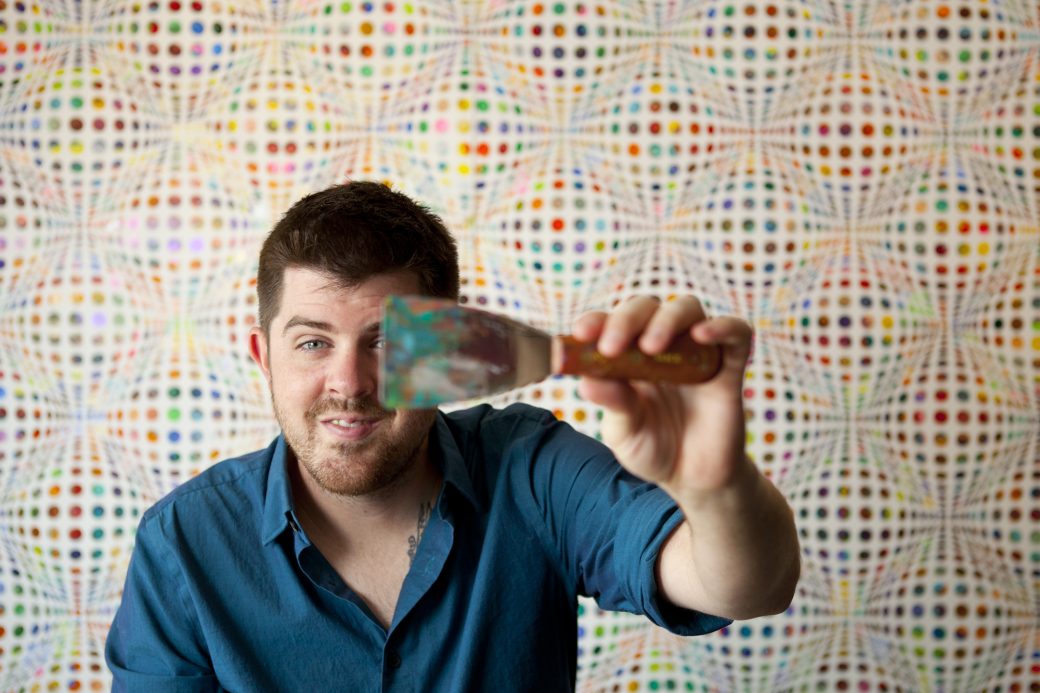Sean Ward is an exciting American talent who has already adorned countless exhibitions throughout the US with his signature stenciled works, each full of color, innovation and a psychedelic touch. Forming a fascinating marriage between technology and tradition, he jumps from the computer to the studio to build a standout body of work. Read on to see how he does it…
Good morning, Sean! What’s the first thing you do when you wake up in the morning?
Funny story: I actually work at night, so I wake up in the evening! In the morning, when I’m done working in the studio, I fix my daily buttered toast and drink a protein shake. It might seem boring, but it keeps me healthy to work 60+ hours a week in the studio!
What inspires you to create every day?
The number one thing that inspires me is building up a collection of work for an exhibition, and the moment I get to debut the artwork to a crowd and all the comments everyone has for the artwork. Art brings joy to so many – it’s a feast for the eyes and it makes children happy to experience something new. I’m continuously inspired by this feeling that I have created something that is bettering the world, even in the smallest degree.
What does your work space look like?
Well, I have a gallery space that I create in sometimes when I need inspiration from other artists’ creativity. Then, I also have a studio space at the STUDIO|SCHOOL, which is an artist colony that allows me to work on larger works. Lastly, I have a smaller studio set up in the basement of my house. It may seem like overkill to have three spaces to work in, but there is purpose within this madness. It allows all of the spaces to stay designated for certain tasks. My home studio is where I design and cut vinyl stencils for my works; STUDIO|SCHOOL is where I paint the works en masse. Then, the gallery is where I typically display and sell the works, and escape from everyone when I need breaks from reality.

Describe the core of your technique or style.
My process is a mixture of technology and tradition. I begin with the technology aspect by designing all my work in Adobe Illustrator as line art. This is to visualize how the final piece will turn out, and to make guidelines for a machine to cut huge stencils, so that I can block the colors from entering the white space. Then, once that is transferred onto wooden panels, I go in with palette knives and create abstract paintings within the positive space of the works. I then remove the stencils, to preserve the clean and crisp white space.
Do you have any studio rituals or necessities?
So, this is a funny subject to me and it correlates directly to my artwork. As a hobby, I like to DJ and produce music with a buddy of mine. Whenever I’m painting in the studio, I always blast music we’ve made or listen to other DJs’ music – I need inspiration and energy to power through the long days and nights in the studio! Then, the necessities that I always have in the studio are my numerous rolls of green frog tape and X-acto Z knife blades. I use these every single working day.
How do you choose the colors for each of your works?
I go through a very interesting process, which began nearly 6 years ago when I started writing a book – or what most would call reference guide – on colors used throughout modern culture and history. The book is best described as an encyclopedia, where over 140,000 entries have been made on numerous colors, via hexcode and cataloged digital spectrometer. As a result of having looked at the near exact same colors constantly, and how they were used by corporations, older societies and even modern day artists, I began noticing trends in color combinations. Now, it’s almost second nature for me to figure out my color palette before I even add a drop of paint to the wood panels. Typically, I use around 8-24 pure pigment paints for each painting, but lately I’ve started doing some combinations with just 5-6, if it helps the optical effects turn out better.

How do you know or decide when an artwork is finished?
I actually figure out when the painting is done whilst I am applying the layers of marbleized paint to the surface, with the tape still blocking the white surfaces. It will all look like a jumbled psychedelic mess, but I can see right through it in my mind how the final coloration will appear. That’s when the funnest part of the process begins, which I will go over later in this interview!
What do you like to do to unwind after a day’s work?
My favorite after-work adventures include going to local music shows and seeing my friends DJ, going on hikes throughout the country or playing video games with my buddies online.

What’s your overall favorite aspect of the creative process?
The final reveal is, by far, my favorite part of the creative process. The entire painting is completely covered in tens to hundreds of colors of paint and you cannot see any detail of the work, whatsoever, just layers of tape poking up through the paints… Once the paint is completely dry I start removing those layers of tape and then the final image is revealed, as the tape blocks off all the white space and exposes the design as I initially made it on the computer. The result of my fusion of technology and tradition is finally revealed!














